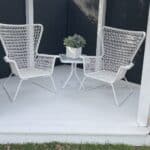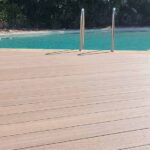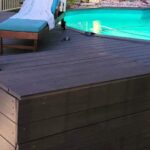What is composite decking, how is it made, how is it different from timber?
WPC is a Wood Polymer Composite
It is simply a mix of powdered wood and plastic bonded together under pressure and high temperature with bonding agents. The quality of the product comes mainly from the quality and purity of the core ingredients, and in particular how finely the wood and plastic are powdered and processed and how well they are mixed with quality bonding agents and UV stabilisers. Boards use recycled materials as it is cost-effective and good for the environment. In many ways it is similar to baking a cake, with clean fine flours, quality butter and yeasts required to make an excellent bread.
The composition of the product means that WPC shares some of the characteristics of both wood and plastic, losing some of the limitations of timber and gaining some of the benefits of plastic.
Virtually all boards are made to use a hidden clip system for installation.
Whilst this provides a great look and easy fixing, in reality, it is needed as composite boards expand and contract with temperature as a result of the plastic component. So fixing directly with screws is not a good idea on anything other than very shortboards.
Boards are made as a solid core or hollow core. We stock only solid cores and believe they are stronger and more durable, because they are. They also allow installation on 450mm joist centers and have a better more solid feel when laid.
WPC boards are often termed ‘first-gen’ and ‘next-gen’.
This represents what in effect are two different styles of boards. ‘First Gen’ is a pure solid composite product, in many ways a timber substitute it is the same product through its core so can be cut trimmed and sanded as you would timber. It has all the advantages of composite with a timber looks and feel. this equates to our CLASSIC™ boards. Manufactured well this is a great board for many decking installations and is very cost effective even against natural timber.
‘Next Gen’, also termed as ‘capped’ or ‘laminated’ decking represent the evolution of the market to more sophisticated products, and to attempt to minimise perceived limitations of WPC. So, with laminated the CLASSIC™ WPC board is also bonded with an outer shell of a virgin plastic, coloured and embossed for style. The quality of the product is then very much dependent on the quality and balance of the shell material used and its thickness. The typical thickness would start about .6mm up to a much less common 1.5mm maximum.
The thicker the shell the more expensive it will be, as virgin plastic is a higher value than recycled. Some boards have a cap on the front face only, on the basis that it is a wasted expense to place a cap on the underside of a board. laminated boards are usually more expensive as a result of higher value materials being used on the surface.
This is our ELITE™ decking board in the products.
Laminated DECKING
What are some similarities between CLASSIC™ (WPC) and ELITE™ (laminated) boards?
- It is waterproof: Both of these types of rigid core boards are highly resistant to water. It is one of the advantages of composite over timber. It can be used confidently in wet environments with no problems, there is a slightly higher resistance with an all-round laminated, yet not so much it will make a practical difference in all but extreme environments.
- Rot and termite resistant: Both products resist any attempts to be eaten by termites.
- Easy installation: Both have clip systems for securing.
- Structural: Both are solid core boards and have similar strength characteristics.
- Maintenance: Neither need any ongoing maintenance beyond cleaning.
What are the main differences between CLASSIC™ (WPC) and ELITE™ (laminated) boards?
- Colours: It is a point that with a good laminated product the colouring will have more depth to the tones, whilst this is, of course, subjective and a matter of choice it provides wider options for customers. Laminated boards are able to be manufactured with two tone colours which are not achievable with CLASSIC™ boards. Laminated can create pure colours, such as White which cannot be achiebed with a CLASSIC™ WPC
- Durability: The main rationale for manufacturing a laminated product was to create a harder more durable surface. WPC will wear and scratch similar to timber (see our product care page) and a well-laminated decking will have a harder shell that makes it more resistant to hard knocks. Laminated composite products often end up in commercial or very high use areas as a result. Conversely, if a laminated composite product has a major knock it can break the shell and expose the core underneath.
- Stain resistance: Whilst both boards resist stains and will wash well if you have accidental spillages there is a higher ability in laminated products as a result of the denser HDPE shell. If you spill your old engine oil over WPC it may leave a subtle mark even after cleaning, with laminated you might well get away with it.
- Style: laminated allows a deeper emboss as mentioned, that allows for more finish options, most laminated boards having a wood effect style to create variance and lustre.
- Slip resistance: Most boards are rated similar and around P4. Slip is a function of the finish on the boards. Having said that, laminated products can hold a deeper embossing and so means that they can be manufactured to hold a higher slip rating if necessary. Sun Decking Elie is rated at P5 commercial wet slip rating.
- Foot Feel: They both have similar thermal characteristics and so feel similar temperatures, some perceive a difference in feel, WPC feeling softer under bare feet. It is not often a deciding factor.
- Fade:The WPC and laminated boards will fade in the first two months in the Sun and then stabilise. laminated boards have a better ability to resist UV fading with minimal tone changes over time, WPC slightly more. We provide samples of WPC that have already been in the sun for several months so you can see what the deck will look like once it’s lived in.
- Price:WPC boards are more cost-effective for the manufacturing reasons mentioned.
Quality Assurance
We at Sun Decking have a simple purpose: To keep our business simple to provide you, our customers, with quality products at outstanding value for money.
The manufacturer we work with has been creating WPC products for over 20 years.
They have a dedicated quality and research team in their business and successfully export to over 50 countries, now we are working with them. They are for this first time supplying the Australian market.
Their confidence in the product durability and longevity is strong, so is ours.
The warranty is a limited warranty against rot, termite infestations, splintering and product failure.
How Long Does Composite Decking Last?
Because of the resistance and durability of composite decking, it can last 25 years.
This is a far stretch from traditional wood products, which do not last as long even with yearly maintenance. We provide a 15-year warranty on our products to assure that we developed our products to last, saving you money in the long run.
The best way to clarify our product characteristics and their suitability for your installation is to talk to us.



